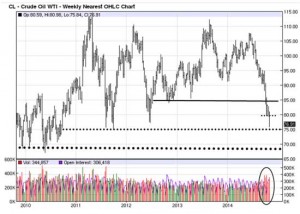Why are oil prices so low?
< < Go Back
by Dan Hassey,
Crude oil prices have dropped more than 25% since their June peak. Since then, oil has been trading in the high-$70s, with WTI crude futures contracts forecasting sub-$80 oil well-into 2016.
The reasons for the continued drop are many: lower demand, rising supplies, a Goldman Sachs (GS) forecast for $75 oil, OPEC and Saudi Arabia not supporting prices. The strong U.S. dollar also means lower energy costs.
That’s good news for consumers, but certainly frustrating not only for investors, but for countries that depend on the money they make from crude oil exports to keep their countries running.
Right now … let’s take a closer look at some of the headwinds that oil and natural gas are facing … and why the headlines might mislead you.
Headwind No. 1: Global Oil Demand
The IEA recently reduced its forecast of global oil demand for 2014 by 0.2 million barrels per day
So, demand dropped about 0.02% per day. This does not warrant a drop of 30% in price.
Also, demand has grown every year since 2009 including 2014.
Headwind No. 2: Global Oil Supplies
Let’s look at the other headline that oil supplies are “surging.”
There is higher oil global output from the U.S. and a few members of OPEC — but not all. Oil production as of September was 93.8 mboe/day.
But while there is more supply than demand, that figure is only about 2%. This also does not justify a 30% decline in prices.
Headwind No. 3: Gains in the Greenback
One other variable we didn’t discuss previously was the strong dollar. I am not convinced this is a major factor, but it is a factor.
Over a long period, I’ve found that the correlation between the dollar and oil is weak.
Headwind No. 4: Saudi Arabia
Vienna, Austria-based OPEC has over 70% of global proved reserves and produces over 20% of global oil supplies. However, Saudi Arabia has always had the most influence among OPEC because it produces the most oil by far. (It also has huge oil reserves.)
OPEC is a cartel and oligopoly that influences global oil supplies and therefore pricing. Its ability to control oil supply and pricing, however, has been mixed for the past few decades.
Most energy followers, including myself, were very surprised that Saudi Arabia has been acting independently when it comes to pricing and supply.
Saudi Arabia’s recent actions have shaken global oil markets.
Will the Saudis’ Strategy Work?
Last week, Saudi Arabia surprised the oil markets again by cutting prices to U.S. markets but raising them in others.
Naturally, financial media has been speculating why the Saudis are doing this. Some “reasons” include:
Punishing Russia for supporting the Shiites and the Syrian Assad regime
Protecting their market share via price competition.
Making U.S. oil shale to be uncompetitive so it can take back market share here.
Some analysts believe the U.S. will end up pressuring Saudi Arabia to back off its current strategy to lower prices in order to protect their global and U.S. market share.
OPEC will decide on Nov. 27 how to proceed on production quotas for next year.
Meanwhile, an OPEC official stated last week that it would support prices if they went below $70.
This brings up the best surprise yet …
Oil prices now have a floor. They have been rallying on this news.
More From Uncommon Wisdom:




